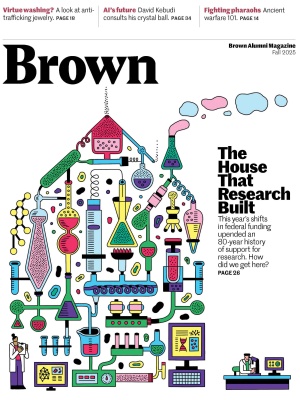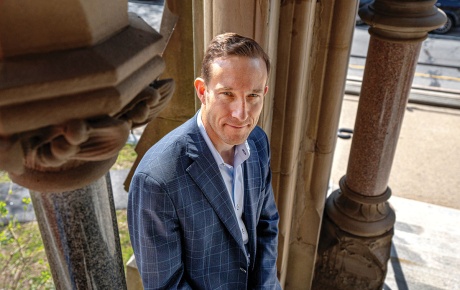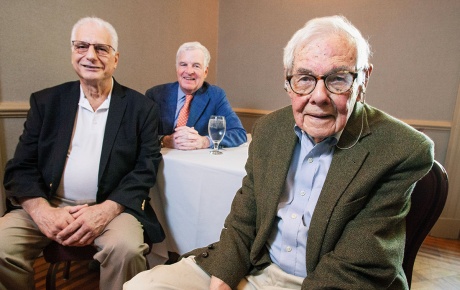Software to the Stars
Can AI solve the universe’s greatest mysteries? These professors are trying to find out.
No two-letter combination may drum up as much existential dread as “AI.” While most AI technologies are merely sequences of highly layered statistical calculations, their extraordinary ability to recognize patterns by training on massive datasets, and then output anything from photorealistic images to
fluent-sounding speech, means that misuse of AI abounds. It’s a bleak discourse. On top of the manipulative chatbots and the fraudulent deepfakes, simpler, less nefarious AI continues to threaten people’s jobs. But here’s the bright side: Some individuals are wielding AI to make truly human progress.
How? Look up at the sky.
For the past 15 years, Jonathan Pober, an associate professor of physics at Brown, has been looking up through the Murchison Widefield Array (MWA), a radio telescope in western Australia. As a collection of antennae spread out over five kilometers, it doesn’t “look” like a normal telescope, but that means it can do something much more exciting: construct images of the early universe.

Here are the fundamentals. Hundreds of thousands of years after the Big Bang, but before stars began to form, the universe was basically a soup of neutral hydrogen atoms. This soup was transparent, radiating no light, except in special, relatively rare circumstances when a hydrogen atom would release a photon of a very specific wavelength, almost exactly 21 centimeters. This is our signal. We on Earth can still detect some of those photons as radio waves, and we have the theoretical knowledge to not only isolate them, but use them to model the structure of the early universe, as it went from hydrogen soup to a space populated with stars and galaxies.
So far, though, the search for that signal has been unsuccessful. “We have a needle in the haystack,” Pober says. “For scale, the signal we’re looking for is about 100,000 times fainter than all the other astrophysical radio signals being made. That doesn’t even account for all the human-generated radio signals— FM radio, digital television, satellite communication.”
That’s where AI comes in. Pober has focused much of the past five years on developing algorithms to overcome key hurdles in his field of research, such as sifting out the human-generated junk in the MWA’s data. The challenges in building this technology, though, have proven just as great as its potential. “ We’ve got 10 terabytes of data to test this interference removal system, and we haven’t found out how to get that into an AI,” Pober says. “I’ve got 40 petabytes of this data [in total]. That’s a thousand times more than what we’re working with.” That too big data problem, among many others, means that in Pober’s line of cosmology, “no one trusts [AI] yet.”
AI has made more headway in other branches of physics research, however. Loukas Gouskos, a particle physicist who joined Brown’s physics department in 2023, has been a pioneer of AI-based research for the Large Hadron Collider (LHC), the revolutionary particle accelerator used to discover the Higgs boson in 2012. For decades, the Higgs boson was the last unconfirmed particle in the Standard Model, our best current theory for how the universe operates on the microscopic scale. Gouskos has led the development of various AI algorithms to more comprehensively study this particle, among other computational pursuits, to utilize the full power of the LHC, the largest machine of its kind, and potentially break through current shortcomings in physics.
An AI-based collaboration between Gouskos, fellow Brown physics professor Stephon Alexander ’95 ScM, ’97 ScM, ’00 PhD, and their students is ambitious on this front. Gouskos, with his experimental background, and Alexander, primarily a theoretical physicist, hope that by combining their research perspectives, they can create new models to probe physics’s biggest mysteries. “ We are trying to explore the unknown using techniques like anomaly detection, teaching our algorithm to learn very well the physics that we know, and if we see something that deviates, it could be a hint for new physics,” Gouskos says. He and Alexander see particular promise in using this technology to characterize dark matter, a hypothetical form of matter that, despite it making up an estimated 85 percent of the universe’s total mass, is nearly impossible to research because it doesn’t interact with light.
The application of AI to physics is intrinsically interdisciplinary. That’s evident by its historical roots, which Alexander himself helped germinate as a graduate student at Brown. “It was the mid-’90s,” he remembers. “Aside from some lone guys like John Hopfield and Geoffrey Hinton, back then, AI and physics was like, what are you talking about? I came up with a collaboration between a cosmologist in the physics department, Robert Brandenberger, and Leon Cooper, who was doing machine learning. It’s interesting because now the interface of AI and astrophysics is a big field. But this was the very first project back in 1995.”
The project, which would’ve examined the large-scale distribution of galaxies, never came to fruition because the computers accessible back then weren’t powerful enough. Alexander, now a tenured professor, sees promise in reviving the idea.
Nevertheless, Alexander, like Pober, recognizes AI’s limits. “Do I think that AI is going to be able to make breakthroughs in theoretical physics? Not at the current moment. I like to think of it as a soundboard, the same way I may talk to a colleague outside of my field, and they may say the silliest thing to me, but it may be useful.”
In fact, physicists, who by the nature of their work are comfortable with uncertainty and the bounds of human knowledge, are perhaps the best equipped of all of us to understand AI holistically, with all its groundbreaking potential and ongoing limitations. AI is just a tool, and it’s one that breaks.
So look up and know that, within this infinite cosmic fabric, under long-dead stars whose light is just gracing our planet, AI is small and it knows little—a lot like us.





